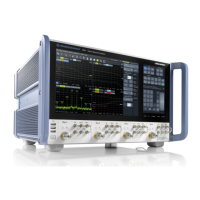GUI reference
R&S
®
ZNA
330User Manual 1178.6462.02 ─ 20
Example 1: A broadband amplifier with a positive gain ranging from 500 MHz to 6 GHz
typically requires sideband correction during a precise NF measurement. For such an
amplifier, several higher-order sidebands of the VNA receiver are within its gain band-
width. At a measurement frequency of 500 MHz, for example, the sidebands of the
VNA receiver are at 1 GHz, 1.5 GHz, 2 GHz. These bands are within the gain band-
width of the amplifier and therefore require sideband correction. Since the DUT does
not have any gain above 6 GHz, the upper frequency of the sideband correction can be
set close to this value (e.g. 7 GHz).
Example 2: A narrowband amplifier with a positive gain ranging from 2.3 GHz to
2.6 GHz typically requires no sideband correction for a precise NF measurement. For
such an amplifier, the sidebands of the VNA receiver (4.6 GHz to 5.2 GHz for the 2nd
sideband, 6.9 GHz to 7.8 GHz for the 3rd sideband) are not within its gain bandwidth.
Note: The sideband order can be decreased after calibration. This allows you to inves-
tigate the effect of the parasitic sidebands, and to increase the measurement speed,
since less additional measurements are required.
Remote command:
[SENSe<Ch>:]NFIGure:HARMonic[:STATe]
[SENSe<Ch>:]NFIGure:HARMonic[:MINFrequency]
[SENSe<Ch>:]NFIGure:HARMonic[:MAXFrequency]
[SENSe<Ch>:]NFIGure:HARMonic[:MAXimumorder]
DUT Correction ← Advanced Settings
Image band correction is only available for frequency converting DUTs. Using this func-
tion requires additional measurement to determine the gain and source noise tempera-
ture at the image band. The additional measurements are automatically carried out
during calibration and measurement. See "Frequency-converting DUTs" on page 264
for details.
Remote command:
[SENSe<Ch>:]NFIGure:RFICorr
Calibration Settings
Opens the calibration setup dialog and activates its "Noise Figure tab" on page 540,
where you can adjust calibration settings such as power levels and detector times.
5.2.5.3 NF quickset dialog
The "Quickset" dialog guides you through to setup of a noise figure (NF) measurement.
Access:
●
Noise Figure tab ("S-Params") > "Quick Setup Noise Figure" tool button
●
Noise figure setup dialog (non-frequency-converting) > "Quickset" tool button
Meas softtool

